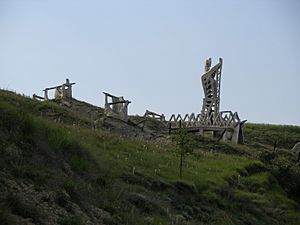Battle of Noáin facts for kids
Quick facts for kids Battle of Noain-Esquiroz |
|||||||
|---|---|---|---|---|---|---|---|
| Part of the Italian War of 1521-26 | |||||||
 Present day monument on the battlefield. |
|||||||
|
|||||||
| Belligerents | |||||||
| Commanders and leaders | |||||||
| Iñigo Fernández de Velasco Antonio Manrique de Lara |
André de Foix | ||||||
| Strength | |||||||
| more than 30,000 | between 8,000 and 10,000 | ||||||
| Casualties and losses | |||||||
| 300 dead | more than 5,000 casualties | ||||||
The Battle of Noáin or the Battle of Esquiroz was a big fight that happened on June 30, 1521. It was the only major open battle during the Spanish conquest of Iberian Navarre. In this battle, the Spanish army won a huge victory against the combined forces of France and Navarre. This event was part of the larger Italian War of 1521-26.
Contents
Why the Battle Happened
The region of Navarre had been taken over by Ferdinand II of Aragon in 1512. Most of it, south of the Pyrenees mountains, became part of the Crown of Castile in 1515.
After a failed attempt to get Navarre back in 1516, the rightful heir to the throne, Henry II of Navarre, saw a new chance. The Castilian army was busy dealing with a rebellion called the Revolt of the Comuneros. This meant many Spanish soldiers were fighting closer to home.
Henry II sent a large army led by General André de Foix across the Pyrenees. This army had about 12,000 foot soldiers, 800 mounted knights, and 29 cannons. With help from the local people, they quickly took over almost all of Navarre in less than three weeks.
The only group that tried to stop them was a Castilian army in Pamplona, led by Ignatius of Loyola. He was badly hurt trying to defend the city's castle. After taking Pamplona, the French and Navarrese army moved into Castile and started to attack the city of Logroño.
Spanish Forces Gather
Meanwhile, the "Revolt of the Comuneros" in Spain was crushed in April. This freed up a huge Spanish army of 25,000 soldiers. They quickly moved towards Navarre. On June 11, General Lesparre stopped his attack on Logroño and pulled his army back into Navarre. On June 30, the two large armies met near Pamplona.
The Battle of Noáin
Where the Fight Took Place
The battle happened on the wide, flat plains between the towns of Noáin and Pamplona. The Spanish army had grown to more than 30,000 men. They were led by Íñigo Fernández de Velasco, who was the Constable of Castile, and the Duke of Nájera, who was the viceroy of Navarre.
The Fight Begins
The Franco-Navarrese army was much smaller, outnumbered three to one. Even so, they attacked first and surprised the Spanish. They had some success at the beginning of the battle.
But then, Fadrique Enríquez, the Admiral of Castile, moved his cavalry (soldiers on horseback) around the Sierra de Erreniega mountains. He attacked the Franco-Navarrese army from behind.
The Outcome
The battle was very fierce and lasted for several hours. In the end, most of the Franco-Navarrese army had to give up. They had lost about 5,000 soldiers. André de Foix, their commander, was wounded in the eyes and taken prisoner. He was later set free after a large payment was made.
What Happened Next
This battle was very important. It decided that Navarre would remain part of the Kingdom of Spain. The rest of Navarre was taken back by the Spanish in the days that followed, with little resistance.
Later Attempts
Lower Navarre, a part of the region, stayed out of Spanish control at first. However, it faced more Spanish attacks and was sometimes occupied over the next seven years. In September 1521, King Henry II of Navarre, with help from Francis I of France, tried again. They launched another attack, aiming for northern Navarre and the city of Hondarribia (Fuenterrabía) between 1521 and 1524. But these efforts did not lead to lasting success.
Navarre continued to be a disputed area and saw small fights along its border for another century. This lasted until the time of Henry III of Navarre (who also became Henry IV of France).
A Monument Today
Today, there is a monument on the battlefield. On the last Sunday of June each year, people who support Navarre's independence gather there.
Sources
See also
 In Spanish: Batalla de Noáin para niños
In Spanish: Batalla de Noáin para niños

